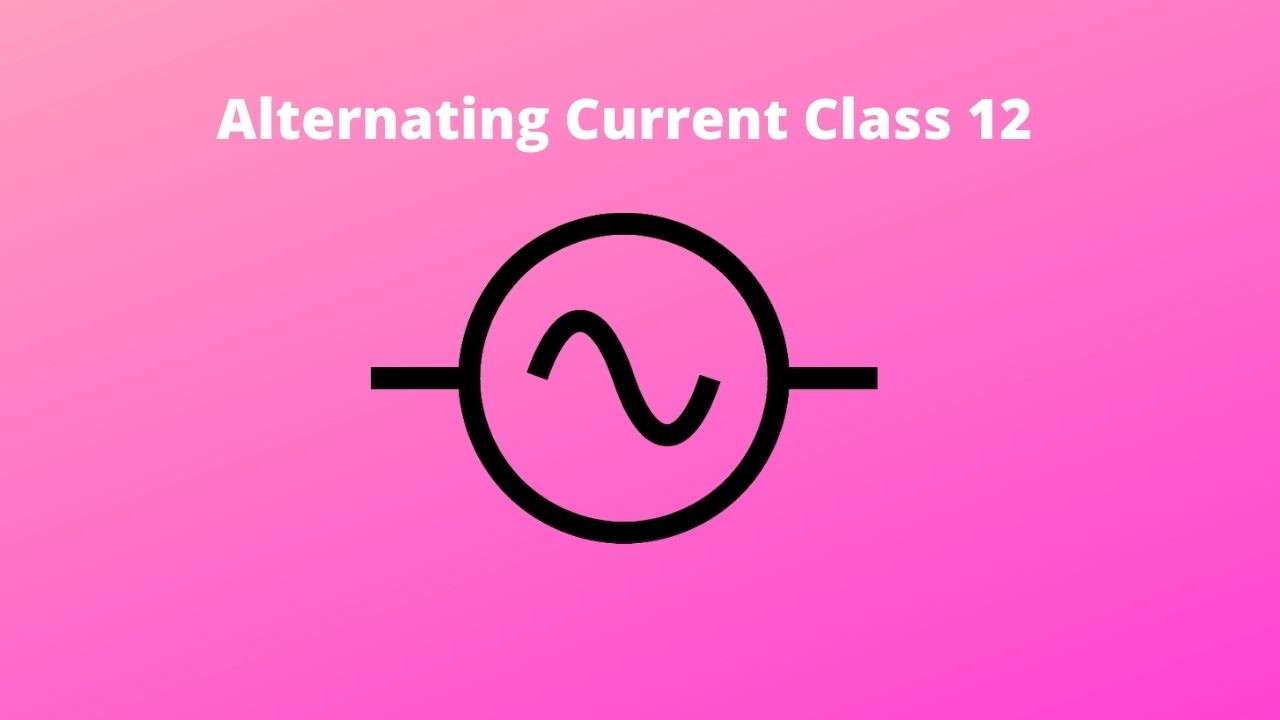Alternating Current Class 12 Notes: CBSE Digital Education provides the best revision notes for the alternating current class 12. Read this article and solve the all-important questions related to the alternating current class 12.
Definition of Alternating Current
An electric current whose direction changes alternating and whose magnitude varies sinusoidally is called alternating current.

It is the close-wise direction for the half-time period and in the anticlockwise direction for the next half-time period. This equation of alternating current is written as
i = ioSin(wt-d)
Where,
Io = Peak current
W = Angular frequency
d = Phase constant
Average Value of alternating current
When we find the average value of alternating current over one time period or over a long time, we get zero because it is positive for the one-half cycle and is negative for the next half-cycle.
The root mean square value of AC
It is defined as the value of a direct current that produces the same heating effect in a given resistor as is produced by the given alternating current when passed for the same time.
- It is also called the virtual value of AC or the effective value of AC.
- It is denoted by Irms.
Root mean square value of alternating emf
It is defined as that value of a steady voltage that produces the same amount of heat in a given resistance as is produced by the given alternating emf when applied to the same resistance for the same time.
AC Dynamo or AC generator
A rectangular coil of several turns is made to rotate in between the two pole pieces of the permanent magnet. When the coil rotates magnetic flux through it varies with time and EMF induced in it.
Quality factor or Q-factor
In series, resonant circuit potential difference across capacitors or potential difference across inductors divided by the potential difference across the resistance is defined as a quality factor.
Sharpness
Sharpness depends on the quality factor, the higher the quality factor higher the sharpness. By decreasing the resistance sharpness can be increased.
Choke coil
It is simply a coil with having large inductance and small resistance. It is used in mercury tubes. It is connected in series to reduce the voltage across the mercury tube.
Since the inductor consumes no electric power but helps to reduce the voltage, hence heat produced is very small. This is the main advantage of the choke coil.
Transformer
The transformer is used to produce high AC voltage from a low-voltage AC source or to produce low AC voltage from a high-AC-voltage source.
Principal of Transformer
Transformer works on the principle of mutual induction.
Construction of Transformer
Two copper coils are bounded at the two arms of the laminated soft iron core. One of the coils is connected to an AC source and it is called primary and another coil is connected to an external circuit and is secondary.
Working process of Transformer
Due to the electric current in the primary circuit, the soft iron core gets magnetized since the electric current in the primary circuit varies with time. Hence magnetic field and magnetic flux associated with the coil vary with time.
Due to a change in magnetic flux, emf induces in both coils. Induced emf of the secondary coil is supplied to the external circuit.
Transformation ratio
The ratio of the number of turns of the primary and secondary coil is called the transformation ratio.
K = NS/NP
(K > 1) for step-up transformer
(K < 1) for step-down transformer
Loss of energy in the transformer
Copper loss: When an electric current passes through the copper coil, heat is produced that is some amount of energy is wastage in the form of heat. To minimize this loss thick copper wire is used in the coil.
Iron loss: When the magnetic field varies with time, an eddy current is produced on the soft iron coil, and thermal energy is produced. To reduce this loss, a laminated soft iron coil is used in the transformer.
Hysteresis loss: Due to magnetization and demagnetization heat is produced in the core of the transformer. To reduce this heated material a thin hysteresis loop is used in a transformer.
Since soft iron material has thin hysteresis, hence it is used in a transformer.
Uses of Transformer
- A step-up transformer is used for the production of X-rays.
- A step-down transformer is used in the induction furnace for melting metals.
- A step-down transfer is used to obtain a large current for electric welding.
- A small transformer is used in telephones, radio receivers, loudspeakers, etc.
- In voltage regulators for TVs, refrigerators, air-conditioners, computers, etc.
- In the transmission of electric energy from the generating stations to the consumers.
Leakage of magnetic flux
The magnetic flux associated with the secondary coil is less than the magnetic flux associated with the term of the primary coil. Some magnetic lines of force leaked out. Due to the loss of magnetic flux, some amount of electrical energy is wasted.
Electric power transmission for long-distance
Alternating current can be supplied to long-distance because it can be stepped up or down. If electric power is supplied from the generating station at 220V then due to large electric power, the current in the wire will be very large and the amount of heat produced is very high wire can melt during the transmission.
To reduce heat energy thick wire can be used but the installation of thick wire is very difficult and its costs are very high.
To remove this difficulty electric power is transmitted at very high voltage by using the step-up transformer at the generating station. Before household use, it is step-down with the help of a step-down transfer, thus electric power is supplied at power voltage.
Difference between AC and DC
The important differences between AC and DC are the following:
- AC is cheaper than DC (Battery is more costly and has limited life).
- AC can be Stepped up and Stepped down, hence it is used in long-distance transmission.
- AC machines are more durable than DC.
- AC is more dangerous than DC.
L-C- Circuit
When a charged capacitor is connected to an ideal inductor, the capacitor gets discharged by sending an electric current to the inductor.
Thus electric field energy of the capacitor is converted into the magnetic field energy of the inductor. The induced emf of the inductor charges the capacitor again.
Thus magnetic field energy of the inductor is converted into the electric field energy of the capacitor. If the resistance of the circuit is negligible then this process is continued for a long time.
We hope you like this article “Alternating current class 12 notes. Comment below for other important topics.
